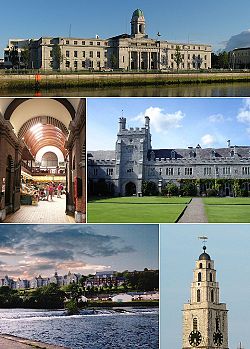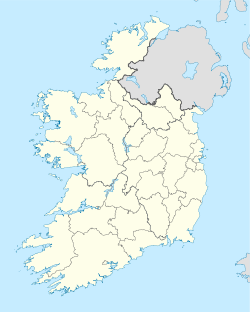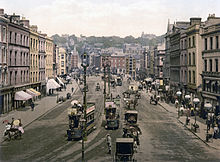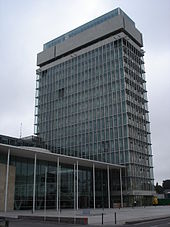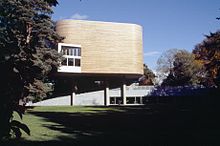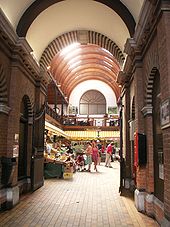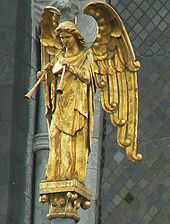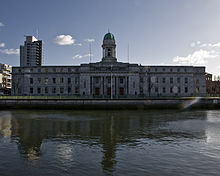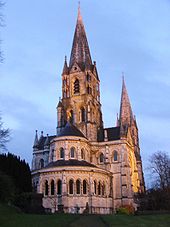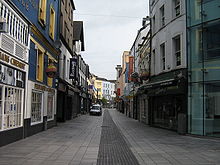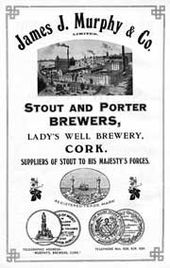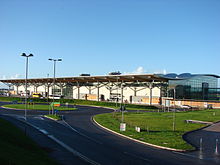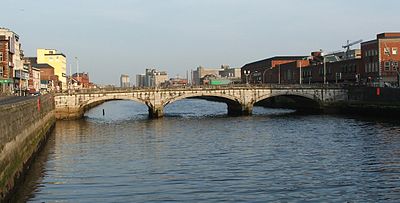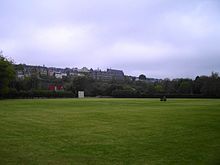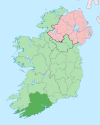- Cork (city)
-
This article is about the city in Ireland. For other uses, see Cork (disambiguation).
Cork
CorcaighFrom top, left to right: City Hall, the English Market, Quadrangle in UCC, River Lee, Shandon Steeple . 
Flag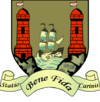
Coat of armsNickname(s): The Rebel City, Leeside, The Real Capital Motto: Statio Bene Fida Carinis (Latin)
"A safe harbour for ships"[1]Coordinates: 51°53′50″N 8°28′12″W / 51.89722°N 8.47°W State Ireland Province Munster County Cork Founded 6th century AD City rights 1185 AD Government - Type City Council - Lord Mayor Mick O'Connell (Labour) - LEAs 6 - Dáil Éireann Cork North Central
Cork South Central- European Parliament South Area - City 37.3 km2 (14.4 sq mi) Population (2006) - City 119,418 - Density 3,194.18/km2 (8,272.9/sq mi) - Urban 190,384 - Metro 274,000 - Demonym Corkonian, Leesider Time zone WET (UTC0) - Summer (DST) IST (UTC+1) Area code(s) 021 Car plates C Website www.corkcity.ie Cork (Irish: Corcaigh, pronounced [ˈkorkɪɟ], from corcach, meaning "swamp") is the second largest city in the Republic of Ireland and the island of Ireland's third most populous city. It is the principal city and administrative centre of County Cork[2] and the largest city in the province of Munster. Cork has a population of 119,418, while the addition of the suburban areas contained in the county brings the total to 190,384.[3] Metropolitan Cork has a population of approximately 274,000, while the Greater Cork area is about 380,000.[4]
County Cork has earned the nickname of "the Rebel County", while Corkonians often refer to the city as the "real capital of Ireland", and themselves as the "Rebels".
The city is built on the River Lee which divides into two channels at the western end of the city. The city centre is located on the island created by the channels. At the eastern end of the city centre they converge; and the Lee flows around Lough Mahon to Cork Harbour, one of the world's largest natural harbours.[5][6] The city is a major Irish seaport; there are quays and docks along the banks of the Lee on the city's east side.
Contents
History
Main article: History of CorkCork was originally a monastic settlement founded by Saint Finbarr in the 6th century.[7] Cork achieved an urban character at some point between 915 and 922 when Norseman (Viking) settlers founded a trading port.[8] It has been proposed that, like Dublin, Cork was an important trading centre in the global Scandinavian trade network.
The city's charter was granted by King John in 1185. The city was once fully walled, and some wall sections and gates remain today.[9] For much of the Middle Ages, Cork city was an outpost of Old English culture in the midst of a predominantly hostile Gaelic countryside and cut off from the English government in the Pale around Dublin. Neighbouring Gaelic and Hiberno-Norman lords extorted "Black Rent" from the citizens in order to keep them from attacking the city. The present extent of the city has exceeded the medieval boundaries of the Barony of Cork City"; it now takes in much of the neighbouring "Barony of Cork". Together, these baronies are located between the Barony of Barrymore to the east, Muskerry East to the west and Kerryycurrihy to the south.
The city's municipal government was dominated by about 12–15 merchant families, whose wealth came from overseas trade with continental Europe – in particular the export of wool and hides and the import of salt, iron and wine. Of these families, only the Ronayne family were of Gaelic Irish origin. The medieval population of Cork was about 2,100 people. It suffered a severe blow in 1349 when almost half the townspeople died of plague when the Black Death arrived in the town. In 1491, Cork played a part in the English Wars of the Roses when Perkin Warbeck a pretender to the English throne, landed in the city and tried to recruit support for a plot to overthrow Henry VII of England. The mayor of Cork and several important citizens went with Warbeck to England but when the rebellion collapsed they were all captured and executed.
A description of Cork written in 1577 speaks of the city as, "the fourth city of Ireland" that is, "so encumbered with evil neighbours, the Irish outlaws, that they are fayne to watch their gates hourly ... they trust not the country adjoining [and only marry within the town] so that the whole city is linked to each other in affinity"
The title of Mayor of Cork was established by royal charter in 1318, and the title was changed to Lord Mayor in 1900 following the Knighthood of the incumbent Mayor by Queen Victoria on her visit to the City.[10]
In the War of Independence, the centre of Cork was gutted by fires started by the British Black and Tans,[11] and the city saw fierce fighting between Irish guerrillas and UK forces. During the Irish Civil War, Cork was for a time held by anti-Treaty forces, until it was retaken by the pro-Treaty National Army in an attack from the sea.
Local government
Historical populations Year Pop. ±% 1659 4,826 — 1813 64,394 +1234.3% 1821 100,658 +56.3% 1831 107,016 +6.3% 1841 80,720 −24.6% 1851 82,625 +2.4% 1861 79,594 −3.7% 1871 78,642 −1.2% 1881 80,124 +1.9% 1891 75,345 −6.0% 1901 76,122 +1.0% 1911 76,673 +0.7% 1926 78,490 +2.4% 1936 93,322 +18.9% 1946 89,877 −3.7% 1951 112,009 +24.6% 1956 114,428 +2.2% 1961 115,689 +1.1% 1966 125,283 +8.3% 1971 134,430 +7.3% 1979 138,267 +2.9% 1981 136,344 −1.4% 1986 133,271 −2.3% 1991 127,253 −4.5% 1996 127,187 −0.1% 2002 123,062 −3.2% 2006 119,418 −3.0% 2011 118,912 −0.4% [12][13][14][15][16][17] Local administration of the area within Cork's city boundary is the responsibility of Cork City Council. While local government in Ireland has limited powers in comparison with other countries, the council has responsibility for planning, roads, sanitation, libraries, street lighting, parks and a number of other important functions. Cork City Council has 31 elected members representing six electoral wards. The party make-up of the council is Fine Gael 8 members, Labour Party 7 members, Fianna Fáil 6 members, Sinn Féin 5 members, Socialist Party 1 member, Workers' Party 1 member, Independents 3 members.[18]
Climate
The climate of Cork, like the rest of Ireland, is mild and changeable with abundant rainfall and a lack of temperature extremes. Cork lies in plant Hardiness zone 10. Met Éireann maintains a climatological weather station at Cork Airport,[19] a few kilometres south of the city. It should be noted that as the airport is at an altitude of 151 metres (495 ft) and temperatures can often differ by a few degrees between the airport and the city itself. There are also smaller synoptic weather stations at UCC and Clover Hill.[19]
Temperatures below 0 °C (32 °F) or above 30 °C (86 °F) are rare. Cork Airport records an average of 1,194.4 millimetres (3.919 ft)) of precipitation annually, most of which is rain.[20] The airport records an average of 8 days of hail and 16 days of snow or sleet a year; though it only records lying snow for 6 days of the year. The low altitude of the city, and moderating influences of the harbour, mean that lying snow very rarely occurs in the city itself. There are on average 151 "rainy" days a year (over 1 millimetre (0.039 in) of rainfall), of which there are 75 days with "heavy rain" (over 5 millimetres (0.20 in)).[20] Cork is also a generally foggy city, with an average of 100 days of fog a year, most common during mornings and during winter. Despite this, however, Cork is also one of Ireland's sunniest cities, with an average of 3.8 hours of sunshine every day and only having 69 days where there is no "recordable sunshine", mostly during and around winter.[20]
Climate data for Cork Airport 1962–1991 Month Jan Feb Mar Apr May Jun Jul Aug Sep Oct Nov Dec Year Record high °C (°F) 12.6
(54.7)13.5
(56.3)15.5
(59.9)20.5
(68.9)23.6
(74.5)25.7
(78.3)28.7
(83.7)27.5
(81.5)24.7
(76.5)19.0
(66.2)15.9
(60.6)13.6
(56.5)28.7
(83.7)Average high °C (°F) 7.6
(45.7)7.5
(45.5)9.3
(48.7)11.3
(52.3)13.8
(56.8)16.6
(61.9)18.5
(65.3)18.2
(64.8)16.0
(60.8)13.1
(55.6)9.9
(49.8)8.5
(47.3)12.5 Daily mean °C (°F) 5.1
(41.2)5.0
(41.0)6.2
(43.2)7.7
(45.9)10.2
(50.4)12.9
(55.2)14.8
(58.6)14.5
(58.1)12.7
(54.9)10.3
(50.5)7.2
(45.0)6.1
(43.0)9.4 Average low °C (°F) 2.6
(36.7)2.5
(36.5)3.1
(37.6)4.2
(39.6)6.5
(43.7)9.2
(48.6)11.1
(52.0)10.9
(51.6)9.4
(48.9)7.5
(45.5)4.5
(40.1)3.7
(38.7)6.3 Record low °C (°F) −8.5
(16.7)−8.6
(16.5)−6.1
(21.0)−2.4
(27.7)−0.9
(30.4)2.4
(36.3)4.8
(40.6)4.9
(40.8)2.3
(36.1)−0.4
(31.3)−3.3
(26.1)−5.9
(21.4)−8.6
(16.5)Precipitation mm (inches) 138.3
(5.445)115.6
(4.551)98.7
(3.886)67.7
(2.665)83.4
(3.283)68.8
(2.709)66.4
(2.614)88.7
(3.492)96.4
(3.795)125.4
(4.937)111.1
(4.374)133.8
(5.268)1,194.4
(47.024)% humidity 90 90 88 83 81 81 83 86 88 91 90 90 87 Avg. precipitation days 20 17 18 14 16 15 14 16 16 19 19 20 204 Sunshine hours 52.70 63.84 108.81 156.30 180.60 171.90 167.40 159.34 123.90 86.80 64.80 48.36 1,387 Source: Met Éireann Culture
Music, theatre, dance, film and poetry all play a prominent role in Cork city life.[citation needed] The Cork School of Music and the Crawford College of Art and Design provide a throughput of new blood, as do the active theatre components of several courses at University College Cork (UCC). Highlights include: Corcadorca Theatre Company, of which Cillian Murphy was a troupe member[21] prior to Hollywood fame; Cork Film Festival,[22] a supporter of the art of the short film;[citation needed] The Institute for Choreography and Dance, a national contemporary dance resource; the Triskel Arts Centre; Cork Jazz Festival; the Cork Academy of Dramatic Art (CADA), and the Graffiti Theatre Company.[23] The Everyman Palace Theatre and the Granary Theatre both play host to dramatic plays throughout the year.
Cork is home to the RTÉ Vanbrugh String Quartet, and to many musical acts, including John Spillane, The Frank And Walters, Sultans Of Ping, Simple Kid and the late Rory Gallagher. Singer songwriter Cathal Coughlan and Sean O'Hagan of The High Llamas also hail from Cork. The opera singers Cara O'Sullivan, Mary Hegarty, Brendan Collins, and Sam McElroy are also Cork born. The short story writers Frank O'Connor and Sean O'Faoláin hailed from Cork. Contemporary writers include Thomas McCarthy, Gerry Murphy, and novelist and poet William Wall. There is a thriving literary community[citation needed] centring on The Munster Literature Centre and the Triskel Arts Centre.
Cork has been gaining cultural diversity for many years as a result of immigration, from Western Europe (particularly France and Spain) in the mid to late nineties, and more recently from Eastern European countries such as Poland, Lithuania, Latvia, Slovakia, Hungary, etc. and in small amount from various African and Asian nations.[citation needed] This is reflected in the recent growth of multi-cultural restaurants and shops, including specialist shops for East-European or Middle-Eastern food, Chinese and Thai restaurants, French patisseries, Indian buffets, and Middle Eastern kebab houses. Cork saw significant Jewish immigration from Lithuania and Russia in the late 19th century. Jewish citizens such as Gerald Goldberg (several times Lord Mayor), David Marcus (novelist) and Louis Marcus (documentary maker) played important roles in 20th century Cork. Today, the Jewish community is relatively small in population, although the city still has a Jewish quarter and synagogue.[24] Cork also features various Christian churches, as well as a mosque. Some Catholic masses around the city are said in Polish, Filipino, Lithuanian, Romanian and other languages,[25] in addition to the traditional Latin and local Irish[26] and English languages.
Recent additions to the arts infrastructure include modern additions to Cork Opera House and the Crawford Municipal Art Gallery. The new Lewis Glucksman Gallery opened in the Autumn of 2004 at UCC, was nominated for the Stirling Prize in the United Kingdom, and the building of a new €60 million School of Music was completed in September 2007. Construction of the €50 million Brookfield UCC Medical School complex was completed in 2005.[citation needed]
Cork was the European Capital of Culture for 2005, and in 2009 was included in the Lonely Planet's top 10 "Best in Travel 2010". The guide described Cork as being "at the top of its game: sophisticated, vibrant and diverse".[27]
There is a rivalry between Cork and Dublin, similar to the rivalry between London and Manchester, Sydney and Melbourne or Madrid and Barcelona. Corkonians generally view themselves as different to the rest of Ireland, and refer to themselves as "The Rebels"; the county is known as the Rebel County. This distinctly Corkonian view has in recent years manifested itself in humorous references to the region as The People's Republic of Cork. Citizens of the Real Capital can be seen adorning themselves with t-shirts and other items which celebrate The People's Republic of Cork, printed in various languages, including English, Irish, Polish, Spanish and Italian.
Food
The city has many local traditions in food. Traditional Cork foods include crubeens, and tripe and drisheen. Cork's English Market sells locally produced foods, including fresh fish, meats, fruit and vegetables,eggs and artisan cheeses and breads. During certain city festivals food stalls are also sometimes erected on city streets - such as St. Patrick's Street or Grand Parade.[28]
Accent
The Cork accent displays various features which set it apart from most of the accents used in Ireland. Patterns of tone and intonation often rise and fall, with the overall tone tending to be more high-pitched than the standard Irish accent. English spoken in Cork has a large number of dialect words that are peculiar to the city and environs. Unlike standard Hiberno-English, some of these words originate from the Irish language, but others through other languages Cork's inhabitants encountered at home and abroad.
Media
Broadcasting
The city's FM radio band features RTÉ Radio 1, RTÉ 2fm, RTÉ lyric fm, RTÉ Raidió na Gaeltachta, Today FM, 4fm, Newstalk and the religious station Spirit Radio. There are also local stations such as Cork's Red FM, Cork's 96FM, 103FM County Sound, CUH 102.0FM, Cork Campus Radio 98.3FM and Christian radio station Life 93.1FM.[29]. Cork also has a temporary licenced city-wide community station 'Cork FM Community Radio' on 100.5FM, which is currently on-air weekends only - Saturdays and Sundays - until May 2012. Cork has also been home to pirate radio stations, most notably South Coast Radio and ERI in the 1980s. Today some small pirates stations remain. A number of neighbouring counties radio stations can be heard in parts of Cork City including Radio Kerry at 97.0 and WLR FM on 95.1.
RTÉ Cork has television and radio studios, and production facilities at its centre in Father Matthew Street in the city centre.
Print
Lapp's Quay in Cork is home to one of Ireland's main national newspapers, the Irish Examiner (formerly the Cork Examiner). It also prints the Evening Echo, which for decades has been connected to the Echo Boys, who were poor and often homeless children who sold the newspaper. Today, the shouts of the vendors selling the Echo can still be heard in various parts of the city centre. One of the biggest free newspapers in the city is the Cork Independent.[citation needed]
Places of interest
Cork features architecturally notable buildings originating from the Medieval to Modern periods.[30] The only notable remnant of the Medieval era is the Red Abbey. There are two cathedrals in the city; St. Mary's Cathedral and St Finbarre's Cathedral. St Mary's Cathedral, often referred to as the North Cathedral is the Roman Catholic cathedral of the city and was built in 1808. St Finbarre's Cathedral serves the Protestant faith and is the more famous of the two. It is built on the foundations of an earlier cathedral. Work began in 1862 and ended in 1879 under the direction of architect William Burges.
St. Patrick's Street, the main street of the city which was remodelled in the mid 2000s, is known for the architecture of the buildings along its pedestrian-friendly route and is the main shopping thoroughfare. The reason for its curved shape is that it originally was a channel of the River Lee that was built over on arches.[31] The General Post Office, with its limestone façade, is one of the most prominent buildings on the street and the focal point of much pedestrian activity. The original building on this site, the Theatre Royal was built in 1760 and burned down in 1840. The English circus proprietor Pablo Fanque, who enjoyed fame again in the 20th Century when The Beatles referenced him in a song, rebuilt an amphitheatre on this spot in 1850, which was subsequently transformed into a theatre and then into the present General Post Office in 1877.[32] [33] The adjacent Grand Parade is a tree-lined avenue, home to offices, shops and financial institutions. The old financial centre is the South Mall, with several banks whose interior derive from the 19th century, such as the Allied Irish Bank's which was once an exchange.
Many of the city's buildings are in the Georgian style, although there are a number of examples of modern landmark structures, such as County Hall tower, which was, at one time the tallest building in the Republic of Ireland[34] until being superseded by another Cork City building: The Elysian. Across the river from County Hall is Ireland's longest building; built in Victorian times, Our Lady's Psychiatric Hospital has now been renovated and converted into a residential housing complex called Atkins Hall, after its architect William Atkins.
Cork's most famous building is the church tower of Shandon, which dominates the North side of the city. It is widely regarded as the symbol of the city. The North and East sides are faced in red sandstone, and the West and South sides are clad in the predominant stone of the region, white limestone. At the top sits a weather vane in the shape of an eleven-foot salmon.[35]
City Hall, another notable building of limestone, replaced the previous one which was destroyed by the Black and Tans during the War of Independence in an event known as the "Burning of Cork".[11] The cost of this new building was provided by the UK Government in the 1930s as a gesture of reconciliation.[36]
Other notable places include Elizabeth Fort, the Cork Opera House, and Fitzgerald's Park to the west of the city. Other popular tourist attractions include the grounds of University College Cork, through which the River Lee flows, and the English Market. This covered market traces its origins back to 1610, and the present building dates from 1786.[37]
Up until April 2009, there were also two large commercial breweries in the city. The Beamish and Crawford on South Main Street closed in April 2009 and transferred production to the Murphy's brewery in Lady's Well. This brewery also produces Heineken for the Irish market. There is also the Franciscan Well brewery, serving the local market with a variety of lagers, ales and stouts. In May 2008 it was awarded as the "Best Microbrewery in Ireland" by Food and Wine Magazine.
Economy
Retail
The retail trade in Cork city includes a mix of both modern, state of the art shopping centres and family owned local shops. Department stores cater for all budgets, with expensive boutiques for one end of the market and high street stores also available. Shopping centres can be found in many of Cork's suburbs, including Blackpool, Ballincollig, Douglas, Ballyvolane, Wilton and Mahon. Others are available in the city centre. These include the recently[when?] completed development of two large malls The Cornmarket Centre on Cornmarket Street, and new the retail street called "Opera Lane" off St. Patrick's Street/Academy Street. The planned Grand Parade scheme for the site of the former Capitol Cineplex has been approved by the planning authorities but for now at least financing hasn't been made available.[citation needed] Cork's main shopping street is St. Patrick's Street and is the most expensive street in the country per sq. metre after Dublin's Grafton Street. Other shopping areas in the city centre include Oliver Plunkett St. and Grand Parade. Cork is also home to some of the country's leading department stores with the foundations of shops such as Dunnes Stores and the former Roches Stores being laid in the city. Outside the city centre is Mahon Point Shopping Centre.
Cork City Centre has seen many retail businesses close down in recent years[when?] due to high rents and the collapse of consumer spending since 2008. Many Cork retail businesses are locked into "upward only" lease contracts meaning rents only increase over time with no account for decreasing sales turnover. Some other very central streets in the city have a large number of unoccupied shops which tend to detract from the City as a whole.[citation needed]
Industry
Cork City is at the heart of industry in the south of Ireland. Its main area of industry is pharmaceuticals, with Pfizer Inc. and Swiss company Novartis being big employers in the region. The most famous product of the Cork pharmaceutical industry is Viagra. Cork is also the European headquarters of Apple Inc. where over 1,800 staff are involved in manufacturing, R&D and customer support.[38] Logitech and EMC Corporation are also important IT employers in the area.[39][40]
The city is also home to the Heineken Brewery which also brews Murphy's Irish Stout and the nearby Beamish and Crawford brewery (taken over by Heineken in 2008) which have been in the city for generations. And for many years, Cork was the home to Ford Motor Company, which manufactured cars in the docklands area before the plant was closed in 1984. Henry Ford's grandfather was from West Cork, which was one of the main reason for opening up the manufacturing facility in Cork.[41] But technology has replaced the old manufacturing businesses of the 1970s and 1980s, with people now working in the many I.T. centres of the city - such as Amazon.com, the online retailer, which has set up in Cork Airport Business Park.[42]
Cork's deep harbour allows ships of any size to enter, bringing trade and easy import/export of products. Cork Airport also allows easy access to continental Europe and Kent Station in the city centre provides good rail links for domestic trade.
Transport
Air
Main article: Cork AirportCork Airport is one of Ireland's main airports and it is a gateway to the south of Ireland. It is situated on the south side of Cork City in an area known as Ballygarvan. Over 15 airlines fly to over 68 destinations with over 60 flights a day. Airlines using Cork airport include Aer Lingus, Aer Lingus Regional, Jet2.com, Monarch, Ryanair and Wizz Air.
Bus
Public bus services within the city are provided by the national bus operator Bus Éireann. City routes are numbered from 1 through to 19 and connect the city centre to the principal suburbs, colleges, shopping centres and places of interest. Two of these bus routes provide orbital services across the Northern and Southern districts of the city respectively. Buses to the outer suburbs, such as Ballincollig, Glanmire and Carrigaline are provided from the city's bus terminal at Parnell Place in the city centre. Suburban services also include shuttles to Cork Airport, and a park and ride facility in the south suburbs.
Long distance buses depart from the bus terminal in Parnell Place to destinations throughout Ireland. Hourly services run to Killarney/Tralee, Waterford, Athlone and Shannon Airport/Limerick/Galway and there are six services daily to Dublin. There is also a daily Eurolines bus service that connects Cork to Victoria Coach Station in London via South Wales and Bristol.
Several private operators also run services to and from the City, with Irish Citylink running services to Limerick and Galway, and Aircoach running a service to Dublin City Centre and Dublin Airport.
Ferry
See also: Port of CorkThe Cross River Ferry, from Rushbrooke to Passage West, links the R624 to R610. This service is useful when trying to avoid traffic congestion in Jack Lynch tunnel and Dunkettle area.[citation needed] The Port of Cork is situated at Ringaskiddy, 16 km SE via the N28. There are Direct services to France and the United Kingdom. A Water Taxi has also been proposed to link the city with towns in the lower harbour.[43][44]
Road
The Cork area has seen improvements in road infrastructure in recent years, especially with regards to National Primary roads. The Cork South Link road (a dual carriageway), built in the early 1980s, linking the Kinsale road roundabout with the city centre was the first of many improvements.
Shortly afterwards, the first sections of the South Ring Road (dual carriageway) were opened. Work continued through the 1990s on extending the N25 South Ring Road with the opening of the Jack Lynch Tunnel under the River Lee being the most significant addition. The Kinsale Road flyover opened in August 2006 to remove a major bottleneck for traffic heading to the Airport or Killarney. Other projects completed at this time include the N20 Blackpool bypass and the N20 Cork to Mallow road projects. The N22 Ballincollig dual carriageway bypass, which links to the Western end of the Cork Southern Ring road was opened in September 2004. City Centre road improvements include the Patrick St. project which reconstructed the street with a pedestrian focus. The M8 motorway links Cork with Dublin. Cork City Council supports a car sharing scheme operated by Mendes GoCar in partnership with cambio Mobility Services. There are several bases in Cork.[45]
Rail
Railway and tramway heritage
Cork was one of the most rail-oriented cities in Ireland, featuring eight stations at various times. The main route, still much the same today, is from Dublin. Originally terminating on the city's outskirts at Blackpool, the route now reaches the city centre terminus of Kent Station via Glanmire tunnel. Now a through station, the line through Kent connects the town of Cóbh east of the city. This also connected to the seaside town of Youghal, until the 1980s.[citation needed]
Other rail routes terminating or traversing Cork city were the Cork, Blackrock and Passage Railway, a line to Macroom, the Cork and Muskerry Light Railway to Blarney, Coachford and Donoughmore, as well as the Cork, Bandon and South Coast Railway connecting Bantry, Skibbereen, Clonakilty and many other West Cork towns. West Cork trains terminated at Albert Quay, across the river from Kent Station (though an on-street rail system connected the two for rolling stock and cargo movement).
Within the city there have been two tram networks in operation. A proposal to develop a horse-drawn tram (linking the city's railway termini) was made by American George Francis Train in the 1860s, and implemented in 1872 by the Cork Tramway Company. However, the company ceased trading in 1875 after Cork Corporation refused permission to extend the line, mainly because of objections from cab operators to the type of tracks which - although they were laid to the Irish national railway gauge of 5 ft 3in - protruded from the road surface.[citation needed]
In December 1898, an electric tram system began operating on the Blackpool–Douglas, Summerhill–Sunday's Well and Tivoli–Blackrock routes. The gauge of the tramway was 90.2 cm (2 ft 11½ in), and designed so that trains from the Cork and Muskerry Light Railway and the Cork, Blackrock and Passage West Railway (which operated on a 3 ft gauge) could connect, using the tram tracks. The half inch difference in the tramway gauge was to allow the broader wheel flanges of the railway rolling stock to run in the tramway grooves. This plan however never came to pass, however there is a photograph in the TMS collection showing a steam train on the tram tracks, dated to the closing day.[citation needed] Increased usage of cars and buses in the 1920s led to a reduction in the use of trams, which discontinued operations permanently on 30 September 1931. The former tramway generating station at Albert Road now houses the National Sculpture Factory and the adjacent tram shed - complete with inspection and service pits (with tram rails still in place) - is also still intact and in use as a commercial premises. Place names today still tell of the routes, such as Tramway Terrace in Douglas.
Current routes
Cork's Kent Station is the main train station in the city. From here, services run to destinations all over Ireland – often via Dublin or Limerick Junction. The main line from Cork to Dublin, Ireland's busiest rail line,[citation needed] has hourly departures and a number of connecting services. InterCity services are also available to Killarney and Tralee, and to Galway (via Limerick Junction and the western corridor).[46]
The Cork Suburban Rail system also departs from Kent Station and provides connections to parts of Metropolitan Cork, including Little Island, Mallow, Midleton, Fota and Cobh. In July 2009 the Glounthaune to Midleton line was reopened, with new stations announced for Carrigtohill, Kilbarry, Monard and Blarney.[47]
Education
See also: Education in Cork and Category:Secondary schools in County CorkCork is an important educational centre in Ireland. University College Cork (UCC), a constituent university of the National University of Ireland, offers a wide variety of courses in Arts, Commerce, Engineering, Law, Medicine and Science. The university was named "Irish University of the Year" in 2003–2004[48] and 2005–2006 by The Sunday Times. Cork Institute of Technology (CIT) was named Irish "Institute of Technology of the Year" in 2006–2007 and offers a variety of third level courses in Computing and IT, Business, Humanities and Engineering (Mechanical, Electronic, Electrical, and Chemical). The National Maritime College of Ireland is also located in Cork and is the only college in Ireland in which Nautical Studies and Marine Engineering can be undertaken. CIT also incorporates the Cork School of Music and Crawford College of Art and Design as constituent schools. The Cork College of Commerce is the largest post-Leaving Certificate College in Ireland and is also the biggest provider of Vocational Preparation and Training courses in the country. Other 3rd level institutions include Griffith College Cork, a private institution, and various other colleges.
Sport
See also: List of Cork people – SportsRugby, gaelic football, hurling and association football are popular sporting pastimes for Corkonians.
Gaelic games
Main article: Cork GAAHurling is the most popular spectator sport in the city, and has a strong identity with city and county – with Cork winning 30 All-Ireland Championships . Gaelic football is also popular, and Cork has won 7 All-Ireland Senior Football Championship titles. There are many Gaelic Athletic Association clubs in Cork City, including St. Finbarr's, Glen Rovers, Na Piarsaigh, Erins Own and Nemo Rangers. The main public venues are Páirc Uí Chaoimh and Páirc Uí Rinn (named after Christy Ring).
Association football
Main article: League of Ireland in Cork cityCork City FC are the largest and most successful association football team in Cork, winning two League of Ireland titles, two FAI Cup titles, and one "All Ireland" Setanta Sports Cup title. Association football is also played by amateur and school clubs across the city, as well as in "five-a-side" style leagues.
Rugby
Rugby union is played at various levels, from school to senior league level. There are two first division clubs in Cork city. Cork Constitution (three-time All Ireland League Champions) play their home games in Ballintemple and Dolphin R.F.C. play at home in Musgrave Park. Other notable rugby clubs in the city include, Highfield, Sunday's Well and UCC. At schools level, Christian Brothers College and Presentation Brothers College are two of the country's better known rugby nurseries. Munster Rugby plays half of its home matches in the Magners League at Musgrave Park in Ballyphehane. In the past Heineken Cup matches have also been played at Musgrave Park but now, due to capacity issues these are now played at Thomond Park in Limerick. In May 2006 and again in May 2008 Munster became the Heineken Cup Champions, with many players hailing from Cork city and county.
Cork's rugby league team, the Cork Bulls, were formed in 2010 and play in the Munster Conference of the Irish Elite League.
Water sports
There are a variety of watersports in Cork, including rowing and sailing. There are five rowing clubs training on the river Lee, including the Shandon, UCC, Pres, Lee and Blackrock clubs. Naomhóga Chorcaí is a rowing club whose members row traditional naomhóga on the Lee in occasional competitions. The "Ocean to City" race has been held annually since 2005, and attracts teams and boats from local and visiting clubs who row the 24 kilometres (15 mi) from Crosshaven into Cork city centre.[49] The decision to move the National Rowing Center to Inniscarra[50] has boosted numbers involved in the sport.[citation needed] Cork's maritime sailing heritage is maintained through its sailing clubs. The Royal Cork Yacht Club located in Crosshaven (outside the city) is the world's oldest yacht club, and "Cork Week" is a notable sailing event.[51]
Cricket
The most notable cricket club in Cork is Cork County Cricket Club, which was formed in 1874. Although located within the Munster jurisdiction, the club plays in the Leinster Senior League.[52] The club plays at the Mardyke, a ground which has hosted three first-class matches in 1947, 1961 and 1973. All three involved Ireland playing Scotland.[53] The Cork Cricket Academy operates within the city, with the stated aim of introducing the sport to schools in the city and county.[54] Cork's other main cricket club, Harlequins Cricket Club, play close to Cork Airport.[55]
Other sports
There are Cork clubs active nationally in basketball (Neptune and UCC Demons) and golf, pitch and putt, hockey, tennis and athletics clubs in the Cork area.
The city is also the home of road bowling, which is played in the north-side and south-west suburbs. There are also boxing and martial arts clubs (including Karate, Muay Thai and Taekwondo) within the city. Cork Racing, a motorsport team based in Cork,[56] has raced in the Irish Formula Ford Championship since 2005. Cork also hosts one of Ireland's most successful Australian Rules Football teams,[57] the Leeside Lions, who have won the Australian Rules Football League of Ireland Premiership four times (in 2002, 2003, 2005 and 2007).[57][58]
Twinning
Cork is a member of the Most Ancient European Towns Network[59] and also twinned with the following places[60]:
Categories:- Cork (city)
- Populated places established in the 6th century
- Cities in the Republic of Ireland
- Populated coastal places in the Republic of Ireland
- County Cork
- Port cities and towns in the Republic of Ireland
- Local administrative units of the Republic of Ireland
- County towns in the Republic of Ireland
- Viking Age populated places
- Staple ports
- European Capitals of Culture
- Munster
Wikimedia Foundation. 2010.

